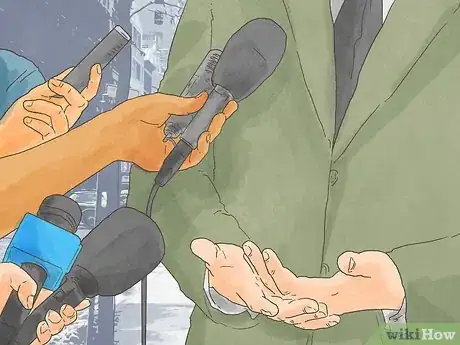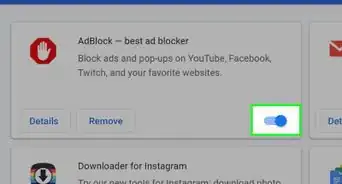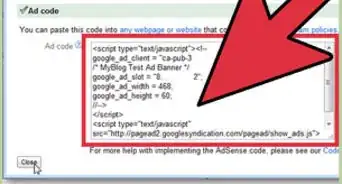wikiHow is a “wiki,” similar to Wikipedia, which means that many of our articles are co-written by multiple authors. To create this article, volunteer authors worked to edit and improve it over time.
This article has been viewed 27,582 times.
Learn more...
Political advertising includes print ads, radio ads, television ads and digital advertising which promotes the election or defeat of a particular candidate, political party or public policy issue. The number and intensity of political ads often increases during election seasons, and in order to keep elections fair and open and citizens informed, candidates, political parties and funding groups are required to disclose who pays for and approves of each ad. Use disclaimers in political advertising by including a brief statement alerting voters to who paid for the ad and, if applicable, whether a specific candidate approves it.
Steps
Knowing When a Disclaimer Is Required
-
1Use a disclaimer if you are a candidate, political party or election committee sending out public campaign communications.
- Check with the Federal Election Commission (FEC) on what constitutes public communications. Always included are television, Internet or radio ads, print ads in newspapers and magazines, outdoor advertising such as billboards or yard signs, mass mailings, emails and websites available to the public.
-
2Include a disclaimer when soliciting funds. Candidates, individuals, and political action committees must disclose who is paying for any ads that ask for donations.Advertisement
-
3Do not include a disclaimer if it is impossible to print one. For example, if you are handing out pencils supporting a particular candidate, there may not be enough space for a disclaimer.
-
4Follow the FEC's recommendation to include a disclaimer on all reasonable campaign materials. If you are in doubt about whether a disclaimer is needed, it probably is.
Knowing What the Disclaimer Must Say
-
1Identify who paid for the political advertisement on any communication that is paid for and authorized by the candidate or the candidate's campaign committee.
- Keep this type of disclaimer simple. For example, it could say "Paid for by the Clark for Congress Committee" or "Paid for by Mary Martin, candidate for President."
-
2Include a disclaimer regarding payment and authorization on any public communication that is paid for by another group or individual instead of the candidate.
- Write or say something like "Paid for by the Committee for Freedom and approved by Clark for Congress."
- Indicate that the candidate approved the message any time a third party runs a political ad that the candidate does support and authorize.
-
3Include a more complex disclaimer when a group or individual pays for a political ad that is not authorized or approved by a candidate or his/her committee.
- Identify who paid for the ad, include a physical address or website address for that group or individual and state that the communication was not authorized or paid for by the candidate or his/her committee.
- Fit the entire disclaimer into one sentence. For example, "Paid for by the Committee for Frogs (www.frogs.org) and not authorized by any candidate or candidate's committee" will cover you.
-
4Identify a political party that pays for any ads or political communications. For example, "Paid for by the Florida Republican Party."
- Do not include any approvals or authorizations in your disclaimer if you are a political party running a general ad about an issue or a group of issues and the ad is not meant to support a specific candidate.
- Include the authorization disclaimer if the political party's ad is on behalf of a specific candidate. For example, "Paid for by the Florida Democratic Party and authorized by the Clark for Congress Committee."
-
5Knowing Where to Place the Disclaimer
-
6Make sure the disclaimer is "clear and conspicuous" on the communication, as required by the FEC.
-
7Place the disclaimer in a printed box, apart from all other content on printed materials.
- Make sure it is typed in a font and size that is clearly readable. The FEC recommends a 12-point type size and ink that sets it apart from the background of the page or surface.
- Put the disclaimer on the front of a single-sided communication or a billboard. If your political ad is several pages long, it can be placed anywhere.
-
8Make an oral disclaimer when running a radio or television ad.
- Use the voice of the candidate any time he or she has paid for or approved the message.
- Include an image of the candidate on television ads.
-
9Put a clear and readable written disclaimer on a television ad for at least 4 seconds.
-
10Include an oral and written disclaimer that identifies the group paying for the television ad when a candidate does not approve the message.
- Use a simple statement, such as "The Committee for Frogs is responsible for this ad."
Community Q&A
-
QuestionHow do I write a disclaimer for a party fundraising tickets?
 Community AnswerIt depends on what liabilities you are wanting to try to protect from by printing a disclaiming statement. However, some examples could be strict and precise statements like "Paid for the committee to elect so-and-so -- the views expressed are those of the speaker and not necessarily those of the Grand Ballroom Hotel & Convention Center, its employees or directors." Or you could write something more natural in tone like "the Trans-Galactic Chaos Party invites you to an evening of food and fun that will benefit our mission of advancing policies that destabilize the gravitational constant throughout the Local Cluster and beyond."
Community AnswerIt depends on what liabilities you are wanting to try to protect from by printing a disclaiming statement. However, some examples could be strict and precise statements like "Paid for the committee to elect so-and-so -- the views expressed are those of the speaker and not necessarily those of the Grand Ballroom Hotel & Convention Center, its employees or directors." Or you could write something more natural in tone like "the Trans-Galactic Chaos Party invites you to an evening of food and fun that will benefit our mission of advancing policies that destabilize the gravitational constant throughout the Local Cluster and beyond." -
QuestionWhat if an electronic billboard has not been authorized to advertise a political candidacy?
 Community AnswerThe designer, manufacturer, and fitter (the person who fits the billboard onto something) can all be sued for up to $1,000,000, which will go to the White House. Alternatively, if the advertiser claims they have not been authorized ON the billboard (not in an interview or speech), they can be fined up to $100,000 and potentially go on the "no vote" list (not allowed to vote in any election for 10 years).
Community AnswerThe designer, manufacturer, and fitter (the person who fits the billboard onto something) can all be sued for up to $1,000,000, which will go to the White House. Alternatively, if the advertiser claims they have not been authorized ON the billboard (not in an interview or speech), they can be fined up to $100,000 and potentially go on the "no vote" list (not allowed to vote in any election for 10 years).



































































